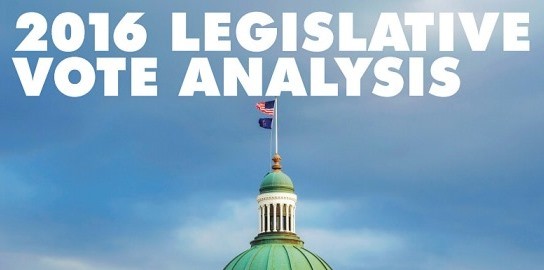[tube]tLY-WWlp1PE&feature[/tube]
The following is the third in our series of Beyond the Bicentennial letters, addressed to gubernatorial candidates. Read them all at www.indianachamber.com/letters.
Dear Mr. Gregg and Lt. Gov. Holcomb:
For Indiana to be the state we all want it to be – one that inspires business location and expansion, brings good-paying jobs to Hoosiers and allows for a high quality of life – a solid infrastructure framework must be in place that reflects both present conditions and is prepared for future developments.
The Superior Infrastructure economic driver in our Indiana Vision 2025 plan champions that belief, with goals regarding transportation, energy, water and telecommunications – all things sometimes taken for granted but inherently critical to running a business and enjoying the comforts of daily life.
Reliable roads and bridges doesn’t seem like a lot to ask for (especially for the Crossroads of America), yet it takes significant investment to keep them functioning, make enhancements and build anew. Frankly, our state has not done enough in recent years and has thus fallen behind.
In 2016, the state Legislature opted to provide short-term funding with a task force set up for the next phase. We all should know at this point – based on studies, reports and simply travelling across the state – that what Indiana desperately needs is a long-term, sustainable, strategic policy plan. One that lasts decades, not a few years or election cycles. And above all, it must be based on the principles that enough revenue is raised to completely fund both maintenance needs and important new projects, and that every user pays their fair share.
There are a number of strategies that should be on the table – any or all of which the Indiana Chamber could support:
- Index fuel excise taxes/fees to inflation
- Raise fuel excise taxes/fees
- Charge fees for alternative-fuel vehicles (which aren’t subject to the regular fuel tax)
- Tolling a major interstate
- Dedicate all of the sales taxes on fuel to infrastructure (the current model allots a penny with the other six cents going to the state’s general fund), and replace the revenue lost to the general fund with another revenue source so that the general fund is left whole
But, realistically, how we get there matters far less than advancing to the point where we have a robust transportation fund. It’s time to finally address this in 2017 – hopefully in a bipartisan way – before it becomes a crisis.
For decades, many companies have located in Indiana because of its adequate, reliable and affordable supply of electricity. But now that coal – Indiana’s most plentiful energy source – has come under frequent attack by the Obama administration, affordability is starting to go out the window. And how long will it be before businesses and jobs go with it?
Unfortunately, Indiana is to some degree at the mercy of the incoming president and the Environmental Protection Agency. However, we can take additional proactive steps at the state level to combat their actions against coal.
One avenue is to focus on diversifying Indiana’s energy mix with an emphasis on clean coal, natural gas, nuclear power and renewables. Development and execution of a statewide energy plan (which does not currently exist) is essential.
Turning the attention to water, we need to finish the good work that stemmed from the Indiana Chamber’s 2014 water resources study and legislation carried by Sen. Ed Charbonneau and others to develop and implement a statewide water resources plan.
We must ensure that future water resources are available – our ability to effectively compete with other states depends on it. And we are approaching the point where research and data collection should soon transition to action. Leadership must be shown by the next Governor to help spearhead the process.
While the need for water has been obvious since the beginning of time, the advent of broadband and its economic significance is a much more recent development. It wasn’t that long ago that broadband was spoken about only in terms of faster and more reliable internet entertainment. But today, and in the future, its business, medical, security and quality of life impacts are paramount.
Legislation in 2015 that created the Broadband Ready Communities Development Center assists rural locales in working through the barriers they might have to broadband investment by a provider.
But not enough is happening and not quickly enough. We must find more ways to bring the most rural parts of Indiana up to date technologically to help reverse their downward population and economic trends.
That sentiment – being more aggressive – easily could be said for all of these infrastructure components. If elected Governor, we strongly encourage you to make that shift and put a greater priority on these vital issues.
Sincerely,
Kevin M. Brinegar
President and CEO
Indiana Chamber of Commerce, representing 24,000 members and investors statewide


 Indiana Chamber executives comment on Gov.-elect Eric Holcomb’s legislative agenda announced today.
Indiana Chamber executives comment on Gov.-elect Eric Holcomb’s legislative agenda announced today. In 2014, President Obama directed the U.S. Department of Labor (DOL) to update and modernize rules regulating exemption of certain employees from minimum wage and overtime protection provisions of the Fair Labor Standards Act. Just a few weeks ago, the U.S. DOL released regulations regarding new rules for overtime. This action drastically increases the salary threshold under which most employees would be eligible for overtime pay, from $23,660 for a full-time employee to $47,476 per year. This will affect millions of middle-wage employers across the country.
In 2014, President Obama directed the U.S. Department of Labor (DOL) to update and modernize rules regulating exemption of certain employees from minimum wage and overtime protection provisions of the Fair Labor Standards Act. Just a few weeks ago, the U.S. DOL released regulations regarding new rules for overtime. This action drastically increases the salary threshold under which most employees would be eligible for overtime pay, from $23,660 for a full-time employee to $47,476 per year. This will affect millions of middle-wage employers across the country. The Indiana Chamber handed out scores today to legislators for their performance during the 2016 General Assembly. The numbers, released in the organization’s annual
The Indiana Chamber handed out scores today to legislators for their performance during the 2016 General Assembly. The numbers, released in the organization’s annual  Six years after the Affordable Care Act became law, employers and employees continue to be impacted, and sometimes confused, by its various rules and regulations. You can learn about new tools to answer your questions and benefit your organization as part of the 2016 Connect & Collaborate series.
Six years after the Affordable Care Act became law, employers and employees continue to be impacted, and sometimes confused, by its various rules and regulations. You can learn about new tools to answer your questions and benefit your organization as part of the 2016 Connect & Collaborate series. The U.S. Senate is likely to vote this week on a measure from Senate minority leader Mitch McConnell to stop the Environmental Protection Agency from regulating greenhouse gases as pollutants. Some argue it will be among the most important environmental votes of this decade.
The U.S. Senate is likely to vote this week on a measure from Senate minority leader Mitch McConnell to stop the Environmental Protection Agency from regulating greenhouse gases as pollutants. Some argue it will be among the most important environmental votes of this decade.  Here’s a recent description of pollster Frank Luntz, courtesy of a political blog: "the boyish charlatan who’s been concocting spin for conservative candidates and causes for what seems like a century now, but who still manages to look like the evil Cleaver brother."
Here’s a recent description of pollster Frank Luntz, courtesy of a political blog: "the boyish charlatan who’s been concocting spin for conservative candidates and causes for what seems like a century now, but who still manages to look like the evil Cleaver brother."